Here tradition – ever present in Macedonia – is still vibrant in the villages. Women’s rule at Monoklissia, Fire-walking at Aghia Eleni, Dionysiac dances at Gazoro.
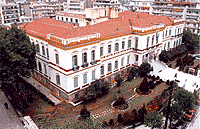 Serres, the prefectural capital, is a modern, bustling city, with broad streets and open squares. The new town blends pleasantly with the old. In its northern sector, on the piney hill of Koula, the ruins of the ancient; acropolis and the Byzantine castle bear witness to a history stretching from the depths of time.
Serres, the prefectural capital, is a modern, bustling city, with broad streets and open squares. The new town blends pleasantly with the old. In its northern sector, on the piney hill of Koula, the ruins of the ancient; acropolis and the Byzantine castle bear witness to a history stretching from the depths of time. 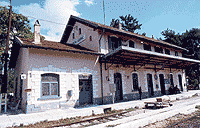 There is also a 14th century church here, dedicated to St. Nicholas with beautiful mosaics. At a distance of 12 kilometers, in a gorge stands the monastery of Timios Prodromos (1270 A.D.) with frescoes of various periods.
There is also a 14th century church here, dedicated to St. Nicholas with beautiful mosaics. At a distance of 12 kilometers, in a gorge stands the monastery of Timios Prodromos (1270 A.D.) with frescoes of various periods.
More antiquities are to be found at Amfipolis, 62 kilometers from Serres, once an Athenian colony, founded in 437 B.C.
Outside the village, near the bridge over the Strimon river, the famous Lion of Amfipolis was discovered, a 4th century B. C. funerary sculpture. The pieces were reassembled and now the Lion guards the bridge.
Sidirokastro, near the Bulgarian border, is a pretty town built on the banks of the Kroussovitis river. It took its name (Iron Castle) from the stronghold on the imposing rock, 155m. above it, that once offered sure protection. The town and the surrounding area are almost overwhelmed by greenery and richly endowed with streams, waterfalls, bridges, churches and monasteries.
 Serres, the prefectural capital, is a modern, bustling city, with broad streets and open squares. The new town blends pleasantly with the old. In its northern sector, on the piney hill of Koula, the ruins of the ancient; acropolis and the Byzantine castle bear witness to a history stretching from the depths of time.
Serres, the prefectural capital, is a modern, bustling city, with broad streets and open squares. The new town blends pleasantly with the old. In its northern sector, on the piney hill of Koula, the ruins of the ancient; acropolis and the Byzantine castle bear witness to a history stretching from the depths of time.  There is also a 14th century church here, dedicated to St. Nicholas with beautiful mosaics. At a distance of 12 kilometers, in a gorge stands the monastery of Timios Prodromos (1270 A.D.) with frescoes of various periods.
There is also a 14th century church here, dedicated to St. Nicholas with beautiful mosaics. At a distance of 12 kilometers, in a gorge stands the monastery of Timios Prodromos (1270 A.D.) with frescoes of various periods.More antiquities are to be found at Amfipolis, 62 kilometers from Serres, once an Athenian colony, founded in 437 B.C.
Outside the village, near the bridge over the Strimon river, the famous Lion of Amfipolis was discovered, a 4th century B. C. funerary sculpture. The pieces were reassembled and now the Lion guards the bridge.
Sidirokastro, near the Bulgarian border, is a pretty town built on the banks of the Kroussovitis river. It took its name (Iron Castle) from the stronghold on the imposing rock, 155m. above it, that once offered sure protection. The town and the surrounding area are almost overwhelmed by greenery and richly endowed with streams, waterfalls, bridges, churches and monasteries.
City of Serres
Serres is the capital of the prefecture of Serres and one of the most important commercial centers (ca 80,000 inhabitants.) in Macedonia, situated at a low elevation (70m). To the North the hills and the first heights of the Vrondou mountain chain embrace the city which has as its typical landmark the hill of the Acropolis (Koulas), while to the South it overlooks the fertile plain, through which the Strymon flows some 24km away.
 The city of Serres, almost entirely rebuilt since the Bulgarian incendiarism, is a pleasant city, with wide streets, surrounded by abundant woods and luxuriant gardens. The city is typical of the ample width of its road structure, its parks, its squares and in general, with anything that might be a reference point to an integral modern city plan.
The city of Serres, almost entirely rebuilt since the Bulgarian incendiarism, is a pleasant city, with wide streets, surrounded by abundant woods and luxuriant gardens. The city is typical of the ample width of its road structure, its parks, its squares and in general, with anything that might be a reference point to an integral modern city plan.
From the ruined castle that crowns the round wooded hill to the north, visitors can enjoy the wonderful view and they are invited to explore the pine-filled hill through many picturesque paths.
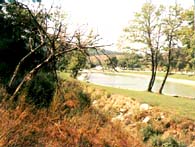 On the way to this hill, located at Exohon Street, there is one of the most beautiful park in Serres, the park of Saints' Anargiri valley. Being close to the center of the town it is used as a place of leisure, sports and entertainment by both the young and the old. Lots of clubs and cafes located in this area offer a lot of opportunities for an exciting night life during the summer months.
On the way to this hill, located at Exohon Street, there is one of the most beautiful park in Serres, the park of Saints' Anargiri valley. Being close to the center of the town it is used as a place of leisure, sports and entertainment by both the young and the old. Lots of clubs and cafes located in this area offer a lot of opportunities for an exciting night life during the summer months.
The city offers a rich cultural activity in many sectors. Athletic, cultural and folklore associations coexist creatively while the City Cultural Center offers an alternative to the creativity and intellectual restlessness of the citizens through the many educational sectors that it provides as well as through the cultural events that it organises. Finally the City Regional Theatre which is committed to looking for ways to satisfy the requirements of its audience is a decisive factor in the cultural matters of Serres.
There are eighteen radio stations and four local television channels. The best-known TV station is TV Serres, whose range covers the Prefectures of Kavala, Chalkidiki, Pella, Kilkis and also a big part of Thessaloniki, Bulgaria and F.Y.R.O. Macedonia. There are also five daily newspapers, five weekly newspapers, two monthly magazines and an annual diary including the events that took place in Serres.
 The city of Serres, almost entirely rebuilt since the Bulgarian incendiarism, is a pleasant city, with wide streets, surrounded by abundant woods and luxuriant gardens. The city is typical of the ample width of its road structure, its parks, its squares and in general, with anything that might be a reference point to an integral modern city plan.
The city of Serres, almost entirely rebuilt since the Bulgarian incendiarism, is a pleasant city, with wide streets, surrounded by abundant woods and luxuriant gardens. The city is typical of the ample width of its road structure, its parks, its squares and in general, with anything that might be a reference point to an integral modern city plan.From the ruined castle that crowns the round wooded hill to the north, visitors can enjoy the wonderful view and they are invited to explore the pine-filled hill through many picturesque paths.
 On the way to this hill, located at Exohon Street, there is one of the most beautiful park in Serres, the park of Saints' Anargiri valley. Being close to the center of the town it is used as a place of leisure, sports and entertainment by both the young and the old. Lots of clubs and cafes located in this area offer a lot of opportunities for an exciting night life during the summer months.
On the way to this hill, located at Exohon Street, there is one of the most beautiful park in Serres, the park of Saints' Anargiri valley. Being close to the center of the town it is used as a place of leisure, sports and entertainment by both the young and the old. Lots of clubs and cafes located in this area offer a lot of opportunities for an exciting night life during the summer months.The city offers a rich cultural activity in many sectors. Athletic, cultural and folklore associations coexist creatively while the City Cultural Center offers an alternative to the creativity and intellectual restlessness of the citizens through the many educational sectors that it provides as well as through the cultural events that it organises. Finally the City Regional Theatre which is committed to looking for ways to satisfy the requirements of its audience is a decisive factor in the cultural matters of Serres.
There are eighteen radio stations and four local television channels. The best-known TV station is TV Serres, whose range covers the Prefectures of Kavala, Chalkidiki, Pella, Kilkis and also a big part of Thessaloniki, Bulgaria and F.Y.R.O. Macedonia. There are also five daily newspapers, five weekly newspapers, two monthly magazines and an annual diary including the events that took place in Serres.
Amphipolis
At about 100km from Thessaloniki, in the direction to Kavala, just beyond the Strymon river bridge, amid low hills (left), are the scattered remains of ancient Amphipolis.
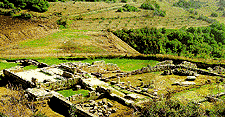 The old bridge over the Strymon is guarded by the Lion of Amphipolis statue; the colossal animal, reassembled from fragments in 1936-37, has been mounted on a pedestal built on the ancient foundation with blocks of the 2C BC dredged from the Strymon, where they may have been reused in a medieval dam. Originally the lion may have honored Laomedon, the sailor of Mytilene who later became the governor of Syria.
The old bridge over the Strymon is guarded by the Lion of Amphipolis statue; the colossal animal, reassembled from fragments in 1936-37, has been mounted on a pedestal built on the ancient foundation with blocks of the 2C BC dredged from the Strymon, where they may have been reused in a medieval dam. Originally the lion may have honored Laomedon, the sailor of Mytilene who later became the governor of Syria.
The city of Amphipolis was built on a commanding eminence (154m) above the E bank of the Strymon, just below its egress from Lake Achinos (now drained), ca. 5km from the sea. A loop of the river flowed round the W half of the city walls.
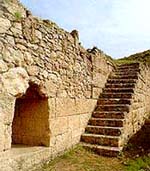 The place, which belonged to the Edonians of Thrace, was originally called "Ennea Odoi" ('Nine Ways'), for which reason, according to Herodotus (VII, 114), Xerxes on crossings its bridges buried alive nine local boys and nine girls. It was colonized as Amphipolis by the Athenians in 437 BC after an abortive attempt 28 years earlier.
The place, which belonged to the Edonians of Thrace, was originally called "Ennea Odoi" ('Nine Ways'), for which reason, according to Herodotus (VII, 114), Xerxes on crossings its bridges buried alive nine local boys and nine girls. It was colonized as Amphipolis by the Athenians in 437 BC after an abortive attempt 28 years earlier.
Deriving its wealth from the gold mines of the Pagaion mountain, Amphipolis was one of their most important N possessions: hence the consternation when it surrendered to the Spartan Brasidas in 424. The historian (and general) Thucydides saved its port of Eion, at the mouth of the Strymon, but, for failing to save Amphipolis as well, he was exiled for 20 years by his countrymen (Thuc. IV, 104-6; V, 26). In 421 the Athenians made an unsuccessful attempt to retake the city; in the cavalry battle both Kleon, the Athenian demagogue and general, and his opponent Brasidas were killed.
Amphipolis was seized by Philip II of Macedon in 358. After the battle of Pydna (168) it became the capital of one of the four republics provisionally set up by the Romans. St. Paul passed through Amphipolis on his way to Thessaloniki ('Acts,' XVII, 1). The city was a station on the Via Egnatia and the seat of a bishop in the Early Christian period. Excavations have been made since 1956 by the Greek Archaeological Service.
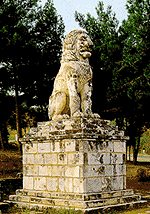 Following the road to Drama, soon (left) there is a small sign in Greek (Macedonian Tomb). Two tombs lie on the hill right of the road: one had been plundered but the other yielded precious articles now in Kavala museum. Further up the road, another sign (left) indicates ancient walls and a short climb above the road, further sections of the defenses can be seen. Substantial remains of a Classical gymnasium have recently been discovered in this vicinity.
Following the road to Drama, soon (left) there is a small sign in Greek (Macedonian Tomb). Two tombs lie on the hill right of the road: one had been plundered but the other yielded precious articles now in Kavala museum. Further up the road, another sign (left) indicates ancient walls and a short climb above the road, further sections of the defenses can be seen. Substantial remains of a Classical gymnasium have recently been discovered in this vicinity.
After another 300m is the turning (left) for the modern village. On the hill opposite the turn is a Hellenist cemetery of rock-cut tombs. In the village, the church contains a relief of Totoes, the Thracian equivalent of Hypnos. Signs lead, through the village and up the hill, towards the main archaeological area, on the acropolis of the ancient city. The principal remains so far excavated are not of the Classical period but of five churches of the 5 and 6C AD, four basilica and one with hexagonal internal layout. Some of the mosaics (including fine and varied representations of birds) can be seen, protected by wooden shelters; others remain semi-permanently covered.
A short distance further up the track are the remains of a Roman house, again under a shelter to protect its mosaics. It has a paved courtyard with a well in addition to mosaic floors and an apsidal room which originally had painted plaster decoration. Beside the house and not yet fully investigated is a building with statue dedications in front. 100m below these structures, down a track, is a remarkable Hellenistic house (covered) with fine painted decoration employing architectural motifs of the kind which formed the basis for the First Pompeian style. A Shrine of Clio borders a deep ravine to the SE.
 The old bridge over the Strymon is guarded by the Lion of Amphipolis statue; the colossal animal, reassembled from fragments in 1936-37, has been mounted on a pedestal built on the ancient foundation with blocks of the 2C BC dredged from the Strymon, where they may have been reused in a medieval dam. Originally the lion may have honored Laomedon, the sailor of Mytilene who later became the governor of Syria.
The old bridge over the Strymon is guarded by the Lion of Amphipolis statue; the colossal animal, reassembled from fragments in 1936-37, has been mounted on a pedestal built on the ancient foundation with blocks of the 2C BC dredged from the Strymon, where they may have been reused in a medieval dam. Originally the lion may have honored Laomedon, the sailor of Mytilene who later became the governor of Syria.The city of Amphipolis was built on a commanding eminence (154m) above the E bank of the Strymon, just below its egress from Lake Achinos (now drained), ca. 5km from the sea. A loop of the river flowed round the W half of the city walls.
 The place, which belonged to the Edonians of Thrace, was originally called "Ennea Odoi" ('Nine Ways'), for which reason, according to Herodotus (VII, 114), Xerxes on crossings its bridges buried alive nine local boys and nine girls. It was colonized as Amphipolis by the Athenians in 437 BC after an abortive attempt 28 years earlier.
The place, which belonged to the Edonians of Thrace, was originally called "Ennea Odoi" ('Nine Ways'), for which reason, according to Herodotus (VII, 114), Xerxes on crossings its bridges buried alive nine local boys and nine girls. It was colonized as Amphipolis by the Athenians in 437 BC after an abortive attempt 28 years earlier.Deriving its wealth from the gold mines of the Pagaion mountain, Amphipolis was one of their most important N possessions: hence the consternation when it surrendered to the Spartan Brasidas in 424. The historian (and general) Thucydides saved its port of Eion, at the mouth of the Strymon, but, for failing to save Amphipolis as well, he was exiled for 20 years by his countrymen (Thuc. IV, 104-6; V, 26). In 421 the Athenians made an unsuccessful attempt to retake the city; in the cavalry battle both Kleon, the Athenian demagogue and general, and his opponent Brasidas were killed.
Amphipolis was seized by Philip II of Macedon in 358. After the battle of Pydna (168) it became the capital of one of the four republics provisionally set up by the Romans. St. Paul passed through Amphipolis on his way to Thessaloniki ('Acts,' XVII, 1). The city was a station on the Via Egnatia and the seat of a bishop in the Early Christian period. Excavations have been made since 1956 by the Greek Archaeological Service.
 Following the road to Drama, soon (left) there is a small sign in Greek (Macedonian Tomb). Two tombs lie on the hill right of the road: one had been plundered but the other yielded precious articles now in Kavala museum. Further up the road, another sign (left) indicates ancient walls and a short climb above the road, further sections of the defenses can be seen. Substantial remains of a Classical gymnasium have recently been discovered in this vicinity.
Following the road to Drama, soon (left) there is a small sign in Greek (Macedonian Tomb). Two tombs lie on the hill right of the road: one had been plundered but the other yielded precious articles now in Kavala museum. Further up the road, another sign (left) indicates ancient walls and a short climb above the road, further sections of the defenses can be seen. Substantial remains of a Classical gymnasium have recently been discovered in this vicinity.After another 300m is the turning (left) for the modern village. On the hill opposite the turn is a Hellenist cemetery of rock-cut tombs. In the village, the church contains a relief of Totoes, the Thracian equivalent of Hypnos. Signs lead, through the village and up the hill, towards the main archaeological area, on the acropolis of the ancient city. The principal remains so far excavated are not of the Classical period but of five churches of the 5 and 6C AD, four basilica and one with hexagonal internal layout. Some of the mosaics (including fine and varied representations of birds) can be seen, protected by wooden shelters; others remain semi-permanently covered.
A short distance further up the track are the remains of a Roman house, again under a shelter to protect its mosaics. It has a paved courtyard with a well in addition to mosaic floors and an apsidal room which originally had painted plaster decoration. Beside the house and not yet fully investigated is a building with statue dedications in front. 100m below these structures, down a track, is a remarkable Hellenistic house (covered) with fine painted decoration employing architectural motifs of the kind which formed the basis for the First Pompeian style. A Shrine of Clio borders a deep ravine to the SE.

